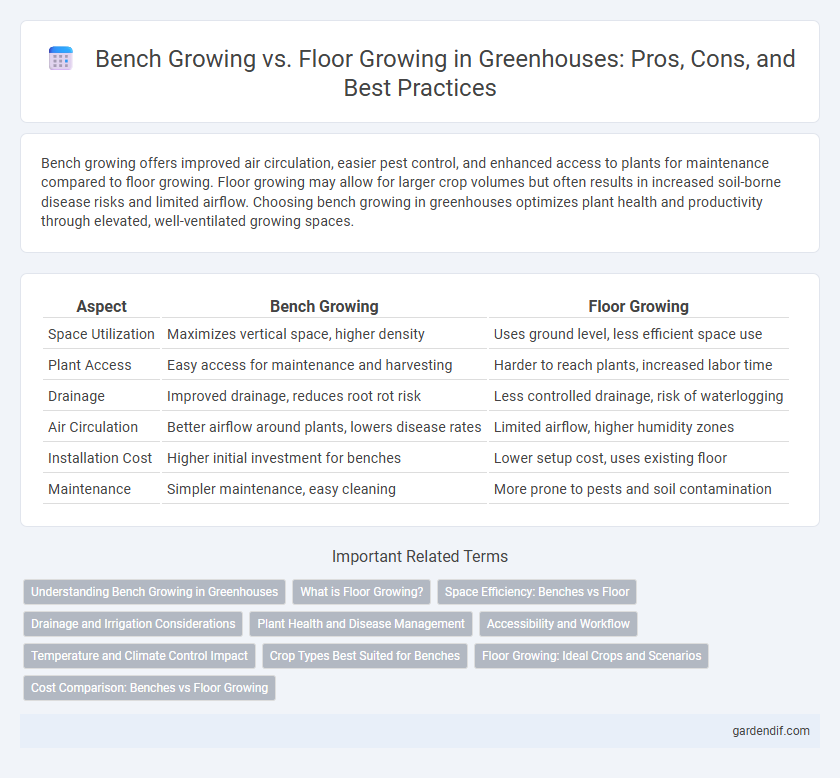
Bench Growing vs Floor Growing Illustration
Bench growing offers improved air circulation, easier pest control, and enhanced access to plants for maintenance compared to floor growing. Floor growing may allow for larger crop volumes but often results in increased soil-borne disease risks and limited airflow. Choosing bench growing in greenhouses optimizes plant health and productivity through elevated, well-ventilated growing spaces.
Table of Comparison
| Aspect | Bench Growing | Floor Growing |
|---|---|---|
| Space Utilization | Maximizes vertical space, higher density | Uses ground level, less efficient space use |
| Plant Access | Easy access for maintenance and harvesting | Harder to reach plants, increased labor time |
| Drainage | Improved drainage, reduces root rot risk | Less controlled drainage, risk of waterlogging |
| Air Circulation | Better airflow around plants, lowers disease rates | Limited airflow, higher humidity zones |
| Installation Cost | Higher initial investment for benches | Lower setup cost, uses existing floor |
| Maintenance | Simpler maintenance, easy cleaning | More prone to pests and soil contamination |
Understanding Bench Growing in Greenhouses
Bench growing in greenhouses optimizes space by elevating plants on raised structures, improving air circulation and reducing soil-borne diseases compared to floor growing. This method enhances plant accessibility for watering, pruning, and harvesting, increasing operational efficiency and crop uniformity. Utilizing bench benches also facilitates better light penetration and temperature control, resulting in healthier, more vigorous plant growth.
What is Floor Growing?
Floor growing in greenhouses refers to cultivating plants directly on the greenhouse floor without raised benches or tables, allowing for larger planting areas and easier management of taller crops. This method maximizes space utilization by enabling dense planting and is commonly used for crops like tomatoes and cucumbers that require substantial root growth and stable support. Floor growing also influences microclimate conditions, impacting soil moisture levels and temperature regulation crucial for optimal plant development.
Space Efficiency: Benches vs Floor
Bench growing in greenhouses maximizes space efficiency by elevating plants, allowing multiple levels of cultivation and improved air circulation. Floor growing occupies the greenhouse footprint entirely at ground level, limiting vertical space utilization and often requiring wider spacing to prevent plant overcrowding. Utilizing benches increases plant density per square meter, optimizing light exposure and ease of maintenance compared to traditional floor planting.
Drainage and Irrigation Considerations
Bench growing in greenhouses offers superior drainage by elevating plants above the floor, reducing waterlogging risks and enhancing root oxygenation, which is crucial for healthy plant development. Floor growing requires efficient irrigation systems to prevent water accumulation and soil compaction, as stagnant water can lead to root diseases and hinder nutrient uptake. Optimal drainage solutions, such as sloped benches and well-designed floor drains, improve irrigation efficiency and promote uniform moisture distribution across all growing areas.
Plant Health and Disease Management
Bench growing enhances plant health by improving air circulation and reducing soil-borne pathogens, which minimizes disease outbreaks compared to floor growing. Elevating plants on benches facilitates better drainage and easier monitoring, preventing waterlogging and fungal infections common with floor cultivation. Floor growing often leads to higher humidity and stagnant air, creating a favorable environment for pests and diseases that compromise plant vitality.
Accessibility and Workflow
Bench growing in greenhouses offers elevated platforms that improve crop accessibility, allowing workers to easily tend plants without excessive bending, which enhances ergonomic workflow and reduces labor fatigue. Floor growing requires more frequent bending and reaching, potentially slowing harvesting and maintenance tasks, thus impacting overall efficiency. Strategic use of bench systems streamlines workflow by organizing crops systematically and facilitating faster movement and care within the greenhouse environment.
Temperature and Climate Control Impact
Bench growing in greenhouses offers superior temperature regulation by elevating plants above cold ground surfaces, reducing frost risk and promoting consistent microclimates ideal for sensitive crops. Floor growing exposes plants directly to soil temperature fluctuations, often causing uneven heat distribution and increased stress during cold or hot conditions. Optimized climate control in bench systems facilitates better airflow and humidity management, enhancing plant health and growth compared to traditional floor cultivation.
Crop Types Best Suited for Benches
Bench growing in greenhouses is ideal for small to medium-sized crops such as leafy greens, herbs, and seedlings that benefit from enhanced air circulation and ease of access for maintenance. Crops like lettuce, basil, and strawberries thrive on benches due to controlled root zone conditions and efficient space utilization. This method supports high-density planting and precise irrigation, making it optimal for high-value, delicate plants requiring frequent monitoring.
Floor Growing: Ideal Crops and Scenarios
Floor growing in greenhouses is ideal for large, heavy crops such as pumpkins, melons, and root vegetables that require ample space and soil depth for optimal growth. This method suits scenarios where high soil moisture retention and natural soil fertility are crucial, offering better water distribution and root development compared to bench growing. Floor growing is especially beneficial in open floor greenhouses with sufficient ventilation and temperature control to support extensive crop root systems.
Cost Comparison: Benches vs Floor Growing
Bench growing in greenhouses offers higher crop density and improved airflow, reducing pest and disease management costs compared to floor growing. Although initial installation of benches involves higher capital expenditure, operational costs such as labor, irrigation, and harvesting efficiency are significantly lower. Floor growing incurs less upfront cost but results in increased maintenance, slower crop cycles, and greater resource usage, leading to higher overall expenses over time.
Bench Growing vs Floor Growing Infographic

 gardendif.com
gardendif.com